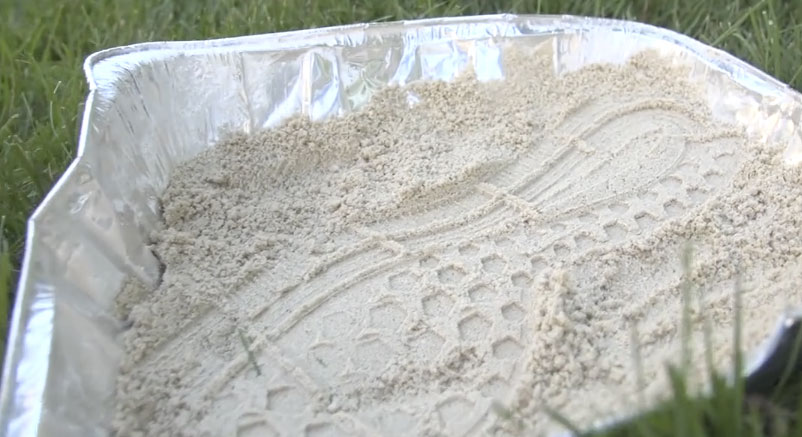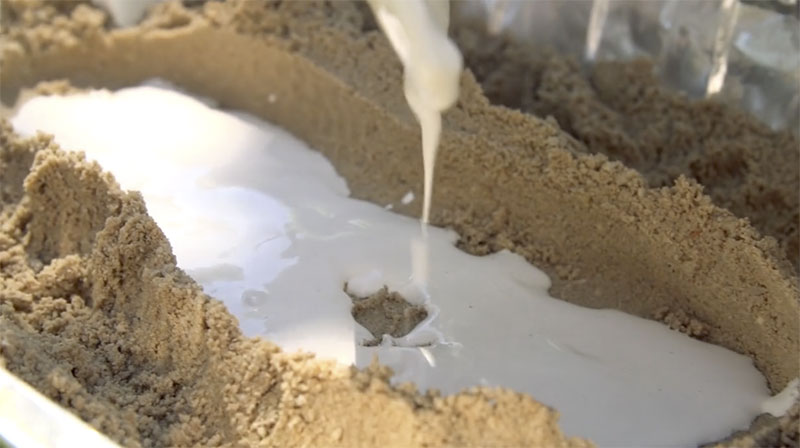Plaster Casting
- Challenging
- Messy
- 60 Minutes
- Outdoor
Set up a mystery, or just plaster cast anything!
The Science-U campers used plaster casts to determine who left shoe prints at the scene of the crime. You can set up your own mystery, or just have fun making plaster casts out of anything you want!
Watch the video on YouTube: https://youtu.be/xzswnyppzFo
You Will Need
Kinetic Sand (purchased, or mix yourself with the next 3 ingredients)
4 cups sand
1 cup cornstarch
1/4 cup water
1 tsp dish soap
Mixing bowl
Disposable aluminum baking pans or plastic food storage containers
Plaster of Paris
Items you would like to cast - you can do shoe prints like the campers, or try anything you’d like - pinecones, seashells, animal figurines, toy cars, even your own handprints or footprints!
**Notes:
The amount of soapy water added to the sand may need to be adjusted if the mixture is too wet or dry. If the sand dries out and they want to use it again, simply add some water to the sand and mix it up. Also, be sure to make the shoeprint pretty deep (at least 1/2 inch, but 1 inch or more is even better) in the sand. If it's too shallow, the plaster will break.
Directions
- Make Kinetic Sand (or purchase)
- Mix together 4 cups of sand and 1 cup of cornstarch in a cake pan.
- Mix together ¼ cup of water and 1 teaspoon of dish soap in a separate bowl until it gets sudsy!
- Pour the water and soap into the cake pan. Mix everything together until a squishy sand forms.
- Spread the kinetic sand out on the bottom of the aluminum pan. Push and flatten it so it is nice and even.
- Push the item you want to make a cast of into the sand to make an imprint. You can make an imprint out of anything you want, such as your hand, your shoe, or even a toy or pet’s pawprint!
- Once you have the imprint you want in the kinetic sand, mix up the plaster of paris. You should make enough to fill the imprint.
- Fill the imprint with the liquid Plaster of Paris. Let it dry (takes about 30 minutes).
- Once the plaster is dry, remove you cast from the sand and clean off the sand. You can then paint your casting if desired.


Experiment Extensions
- Try pressing items into your Plaster of Paris before it dries. Items like flowers, stones, and beads can be used to make patterns!
- Melt crayons in the microwave and pour them into your wet plaster. Swirl the melted crayons with a toothpick to mix up the colors. Let it dry for beautiful artwork!
Discovery Questions
Beginning the Experiment
- Compare the feeling of the kinetic sand to regular play sand. How does it feel the same? How does it feel different?
- Try it!
During the Experiment
- Try using objects that are hard or more squishy. What objects are easiest to make molds from?
- Try it! The hard objects should be easier to press into the sand because they are firm and push into the sand more easily.
After the Experiment
- Observe your plaster cast next to the original object. What is the same? What is different?
- Try it! You should observe that the plaster cast is similar to your original object, but it is a mirror image. This means the structure is reversed, like when you look at yourself in the mirror!
- When might making a cast be useful?
- Crime scene investigators use sand castings to make molds of items found at crime scenes that they cannot move to take back to the lab. Factories use sand casting to make a changeable mold of a piece of equipment. What other uses can you think of?
How it works
The kinetic sand provides you with a changeable mold. Pressing the object into the sand creates a mold for the Plaster of Paris to flow into. When the plaster hardens it takes the shape of the mold from the sand and creates a mirror image of the original object.
Crime scene investigators use sand castings to make molds of items found at crime scenes that they cannot move to take back to the lab. There are many other scientists that use sand casting as well, mostly to make parts for their laboratory equipment.
The benefit to sand casting is that you can change the mold to fit exactly the piece you want. Molds that are made out of other materials are often rigid, or cannot be changed. Scientists make molds out of sand when they need to make a temporary change to a mold they are using.
Manufacturers use sand to cast all sorts of objects, but it is most commonly used to make metal parts. Metal sand castings are produced in special factories called foundries. Over 60% of metal items we use are made through sand casting.
Key Words
- Foundry
- A foundry is a factory that produces metal castings. Metals are cast into shapes by melting them into a liquid, pouring the metal into a mold, and removing the mold material after the metal has solidified as it cools. The most common metals processed in sand castings are aluminum and cast iron.
- Mirror Image
- An image or object which is identical in form to another, but with the structure reversed, as in a mirror.
